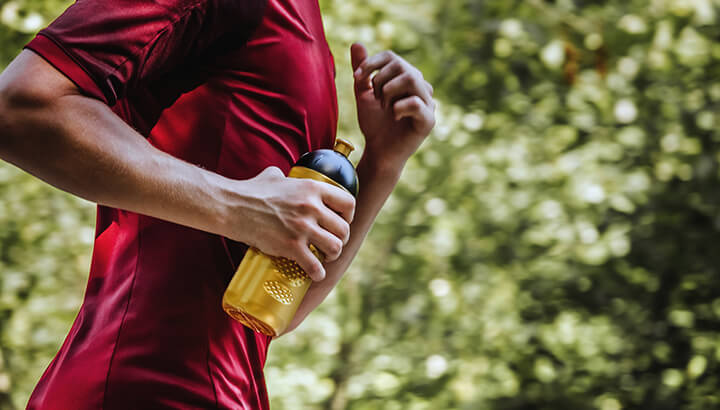Chafing is something both genders face at some point in their lives, but may not ever talk about. Raw and sore nipples may seem like a small thing, but they are no fun. Chafed nipples tend to be red and there can be a burning or stinging sensation — even drops of blood. It’s a sensitive area and really not a place you want to have to deal with pain or tenderness. Let’s get to the bottom of what’s happening here and what can be done about it.
How does nipple chafing happen?
Chafing is caused by repeated motions or friction. That’s why runners tend to be the main victim — with fabric rubbing against their nipples. But chafing can also occur in other areas of the body. It is common around the bra line for women, as well as the inner thighs, the groin, and under the arms.
This means that anyone doing repetitive exercises could have to deal with that stinging redness. Anytime there’s sweat or rain, that means there’s moisture, and that can make chafing even worse. Rough clothing never helps.
Who gets chafing on the nipples?

For runners — especially people who don’t wear bras — chafing is almost guaranteed after a certain amount of time. Long-distance runners report more chafing after three or so miles of running.
In the first few weeks of breastfeeding, many mothers need some time to get used to the strong sucking of their baby, and sometimes there is nipple pain. In most cases, that will eventually go away. The Australian Breast Feeding Association points out that allowing babies to self-attach as often as possible is key to reducing chafing or sore nipples.
Other people who may be susceptible to chafing include bike riders and even anyone out for an innocent long stroll in the intense summer heat. People who are overweight also might experience skin rubbing against skin. But this is something that can be solved and prevented, so don’t let it hold you back.
Do this to help with chafed nipples

If you’re in the middle of doing something, like jogging or you’re at work, Vaseline can be a quick and easy solution to chafing. It works by creating a barrier between cells in dry or damaged skin, thereby locking in moisture. It also keeps other things away, like that rough shirt. If there’s pain, and if you’ve got to make it to the end of your day, be sure to clean your nipples with water and dry them well.
If the chafing is starting to get quite severe with a lot of pain, swelling, bleeding, or crusting, a medicated ointment might be necessary. You might have to consult your doctor or a pharmacist. And if things are this bad, you’ll also want to take a few days off from whatever is causing the chafing and give your nipples time to heal. Any more chafing could lead to an infection — and you really really don’t want that.
For breastfeeding women, breast milk itself can work like magic. According to She Knows and lactation consultant Amy Mager, breast milk can heal wounds. Putting some on your nipples after a feed can work wonders — as long as you don’t have thrush. Nipple creams can also help women. However, they shouldn’t have any dyes or fragrances, if the baby is going to keep feeding.
Prevention is the key for athletes
Prevention is always better than a cure right? One runner told an online doctor, “After this weekend’s Manhattan Half Marathon my nipples bled, I’m in pain still and my favorite T-shirt needs cleaning. I can’t keep doing this.”
Doctor Lewis Maharam was adamant that prevention is in fact very easy. “Dress properly. Wear softer, looser shirts. Avoid a new, unwashed shirt,” he said. He even added that men can go topless if the weather is warm enough.
And here’s something that some active people don’t remember: remove nipple jewelry. “Seems like a no-brainer, but I have seen participants who haven’t realized that their fashion statement was the cause of their problem,” he said.
Runners can also apply a lubricant like Vaseline to the nipple area or use Band-Aids to protect the nipples. Long-distance runners might want to try any non-cotton material that fits well and close to the body. Or, as Maharam said, try clothing that is very loose. Alternatively, any material that dries quickly is the way to go. As noted, wet skin can make chafing worse.
Women should also make sure their sports bras fit snugly. And anyone can apply powders like talcum or alum to those areas that tend to get sweaty. Keeping the skin dry is vital to prevention.
Prevention for breastfeeding moms
Expressing some milk beforehand can soften the areola to help lubricate the nipple. During breastfeeding, women can try different feeding positions, offering the less-sore side first. Afterward, leave your bra open for a few minutes and let your nipples dry. Use breast shells or nipple protectors over tender nipples to allow air to circulate so they can stay dry, as well as to prevent rubbing.
In the end, yes, nipple chafing is a rough problem — but at least there’s a handful of easy solutions. Give some of these a try and let us know how they work.
-The Backyard Vitality Team



